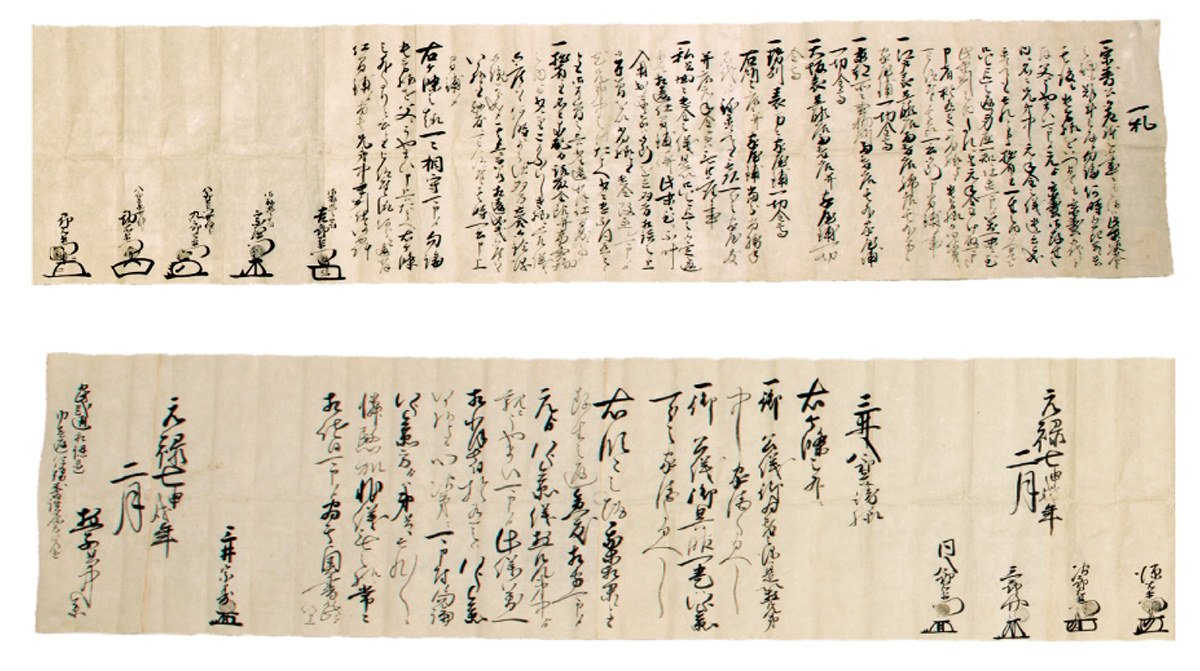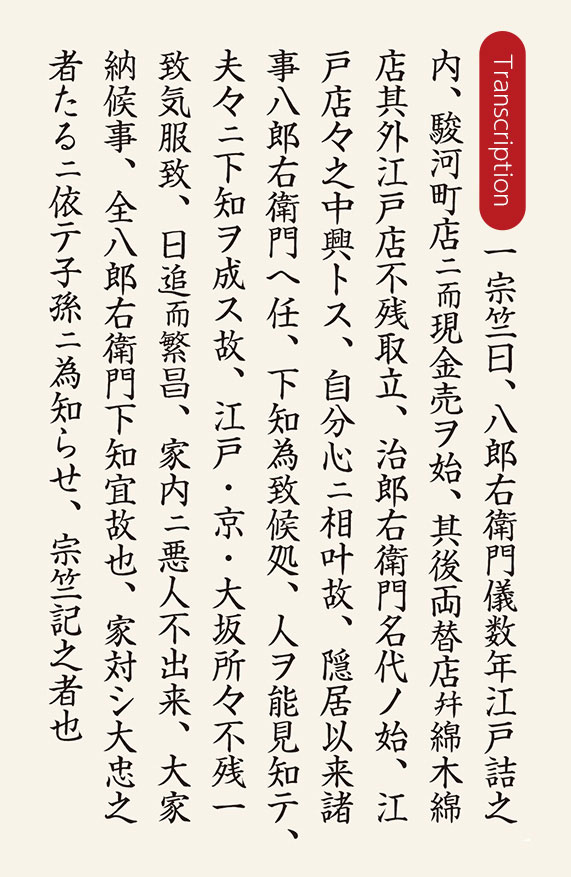06 The Children of Takatoshi

Takatoshi’s Death and His Sons
Takatoshi had many children, and his sons in particular were busy helping their father. In 1694, Takatoshi passed away at the age of 73, but his sons closed ranks and continued to run the business jointly (→Fig. 06c). Takatomi Soan and Shobaiki (→04) offer details about their performance and themselves as individuals.
Takahira (1653-1737), eldest son, 2nd generation head of the main Kita family. Charged with the Kyoto procurements shop, he was a hard worker careless of his appearance who won people’s trust. He kept purchase prices down, which supported bargain prices in Edo. He was person of integrity, and even during those times when they were subjected to intense harassment (→03,05) he was well-thought of by those who were not among his fellow tradesmen. He united the family after his father’s death. Though he retired from active life at age 50, he was the longest lived of all the brothers and in his later years he wrote the family constitution, Sochiku Isho (→09). While meticulous, it is said that he was bighearted and listened well to the opinions of others, and could distinguish well the good and evil in people. Hachiroemon, the first name that he took, came be the name that represented Mitsui. (→Fig. 06b)
Takatomi(1654-1709), 2nd son, 1st generation head of the Isarago family. Managed the Edo shops from their early days. Though sickly, he was full of ambition and possessed powers of imagination. He led a life devoted to business, and came up with new commercial practices. He also poured his energies into the move to Suruga-cho. After his elder brother Takahira retired from active life, he guided business from Kyoto. However, he died suddenly and was succeeded by Takatoshi’s eleventh son Takakatsu.
Takaharu(1657-1726), 3rd son, 1st generation head of the Shinmachi family. Overcame the weak constitution of his younger days to work hard at making procurements in Kyoto. After his father Takatoshi passed away, he inherited the residence at Shinmachi. He also served as superintendent over the adjacent Kyoto money exchange store, which he developed greatly through his careful approach to work. He is said to have been honest, obedient to his elder brothers, and possessed of a disposition to concentrate on one thing at a time.
Takatomo (1659-1729), 4th son, 1st generation head of the Muromachi family. After Takatomi, he was permanently stationed in Edo and developed the Edo money exchange store. With an upright, conscientious, and straitlaced personality, he was seen as the progenitor of Mitsui’s money exchange purveyor’s charter (→05) for the shogunate. Mitsui’s complex system of ledgers is also said to be of his devising.
Takayoshi(1662-1704), 6th son. Though he liked to live extravagantly, he demonstrated his ability to outshine others when it came to in-store sales. Later, he handled procurements in Kyoto. Takayoshi died rather young. In accordance with the Mitsui family code, Takatoshi’s 10th son Takaharu succeeded Takayoshi and established the Koishikawa family.
Takahisa(1672-1733), 9th son, 1st generation head of the Minami family. He was honest, calm, and trustworthy, and was disposed toward forming a clear grasp of things. He greatly improved revenues that came from being a purveyor to the shogunate. Separated by age from his elder brothers, it was expected that he would be the center of the family in the next generation. However, he died ahead of the eldest brother, Takahira.
The Eleven Mitsui Families
The descendants of Takatoshi (known as the “Mitsui Domyo”) later formed eleven families, and it became a tradition to share assets and businesses across all the families. The six families of the sons described above are referred to as the “main families” (honke). Following on these are the five “associate families” (renke) from the female lineages. The first generation heads were Takakata, spouse of Takatoshi’s eldest daughter Chiyo (Matsusaka family); Takahisa, spouse of Takatoshi’s granddaughter Michi (Nagasakacho family); Onoda Takatoshi, spouse of Takahira’s fourth daughter Tami (Onoda family); Iehara Masatoshi, spouse of Takahira’s granddaughter Riku (Iehara family); and Takatoshi’s fourth daughter Kachi (Nagai family). The Matsusaka and Nagasakacho families became illustrious houses in Matsusaka, and they also participated in urban administration. The other nine families lived in Kyoto.
In the latter half of the 19th century, the Onoda, Iehara, and Nagai families broke away. In 1893, three families were established to restore the number of families to eleven. These new ones comprised the Gochome family of Takahisa, who came from the Kita family; the Honmuracho family of Takaakira, who came from the Koishikawa family; and the Ipponmatsucho family of Takanobu, who came from the Isarago family.

Created around 1707. Draft of the family code written by Takatoshi’s second son Takatomi. Only a portion of a clean copy remains extant. A very small part such as the selection extracted here was written by his elder brother Takahira. The content, which begins with a genealogy that starts with Takatoshi’s grandfather Takayasu (→02), ranges widely, covering everything from a history of the Mitsui family to business policies and the system for sharing assets. Sochiku Isho (→09), the family constitution that went into effect in 1722 and set the norms for all that followed, was a continuation and further developed of this code’s content. It is a deeply interesting historical record with many sections that differ considerably from Sochiku Isho, which was compiled during an economic downturn. From it we can learn about the changes in business and in thinking about management.
Takatomi Soan (a draft of the family code written by Takatomi)
Translation
According to Takahira, Takatomi started cash-basis sales at the shop in Suruga-cho during the many years he worked in Edo. Thereafter, he brought prosperity to all of the shops in Edo without exception including the money exchange store and cotton shop, and he was the first to take the name (an important name) of “Jiroemon.” He was the progenitor of the revival at the shops in Edo. Since he met my (Takahira’s) expectations, after I retired from active life I entrusted everything to Takatomi and guided him. Given that he understood well the characteristics of his subordinates and gave them instructions appropriate to each, all of the employees at the shops in Edo, Kyoto, and Osaka respected him sincerely. All of the shops prospered day by day, there were no bad people, and the Mitsui family with its vast numbers was well governed. This is because all of Takatomi’s directions were good. Since he is a person who achieved great things for the Mitsui family, I Takahira write this to inform his descendants.
Description
This selection regarding Takatoshi’s second son Takatomi comes a section that describes the accomplishments and characters of Takatoshi’s children. This is the only section where the eldest brother Takahira wrote additions to Takatomi’s original text.

Depicting him in his later years. The Kita family, with Takatoshi as the first-generation head and with legitimate stem lineages through Takatoshi and Takahira, is also referred as to “main family” (soryoke) and always occupied a prominent place.

Written at the same time as a Takatoshi’s final testament (→01). After their father Takatoshi passed away, the brothers pledged to revere Takahira as his replacement, and continue the family’s businesses as before with no splitting of either assets or shops. The original document is a single scroll presented here in two parts.

